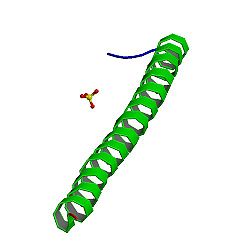Adenomatous polyposis coli-Protein
- Adenomatous polyposis coli-Protein
-
Das APC (Adenomatous Polyposis coli)-Gen ist ein Tumorsuppressor-Gen, welches zuerst bei einem bestimmten Typ von Darmkrebs mutiert gefunden wurde. Jedoch kann dieses Gen auch bei anderen Krebsarten mutieren.
Das Gen ist deshalb so wichtig, weil es für das APC-Protein kodiert, welches im Wnt-Signalweg bei der Degradation von β-Catenin eine entscheidende Rolle spielt. Normalerweise bildet das Protein zusammen mit dem Gerüstprotein Axin und der Proteinkinase GSK-3β einen Proteinkomplex, welcher β-Catenin bindet und seinen Abbau auslöst. Wenn nun eine Mutation in dem APC-Gen entsteht, kann die Affinität von β-Catenin zu dem Komplex gemindert werden und β-Catenin akkumuliert als ob der Wnt-Signalweg aktiviert wäre. Dies führt dazu, dass β-Catenin in den Zellkern wandert und dort TCF bindet und Wnt-Zielproteine wie cMyc exprimiert werden. Die Zelle proliferiert (teilt sich) unkontrolliert, und es bildet sich eine Krebs-Zelle.
Wikimedia Foundation.
Schlagen Sie auch in anderen Wörterbüchern nach:
Adenomatous-polyposis-coli-Protein — Masse/Länge Primärstruktur 2843 aa; 311,6 kD … Deutsch Wikipedia
Adenomatous Polyposis of the Colon — Adenomatous polyposis coli Protein Struktur des N Ende nach PDB … Deutsch Wikipedia
Polyposis coli — Klassifikation nach ICD 10 D12 Gutartige Neubildung des Kolons, des Rektums, des Analkanals und des Anus D12.6 Kolon, nicht näher bezeichnet Polyposis coli (hereditär) … Deutsch Wikipedia
Familial adenomatous polyposis (FAP) — A syndrome characterized by the formation of thousands of polyps in the colon and rectum with colorectal cancer the inevitable consequence. Polyps can also occur in the stomach, duodenum and the terminal ileum. The polyps most often begin to form … Medical dictionary
Secreted frizzled-related protein 1 — The Secreted frizzled related protein (SFRP) family consists of five secreted glycoproteins in humans ( 300 amino acids in length) that act as extracellular signaling ligands. Each SFRP contains a cysteine rich domain (CRD) that shares 30 50%… … Wikipedia
Familiäre adenomatöse Polyposis — Klassifikation nach ICD 10 D12 Gutartige Neubildung des Kolons, des Rektums, des Analkanals und des Anus D12.6 Kolon, nicht näher bezeichnet Polyposis coli (hereditär) … Deutsch Wikipedia
APC (Gen) — Adenomatous polyposis coli Protein Struktur des N Ende nach PDB … Deutsch Wikipedia
PTPN13 — Protein tyrosine phosphatase, non receptor type 13 (APO 1/CD95 (Fas) associated phosphatase), also known as PTPN13, is a human gene.cite web | title = Entrez Gene: PTPN13 protein tyrosine phosphatase, non receptor type 13 (APO 1/CD95 (Fas)… … Wikipedia
PPP2R5A — Protein phosphatase 2, regulatory subunit B , alpha isoform, also known as PPP2R5A, is a human gene. PBB Summary section title = summary text = The product of this gene belongs to the phosphatase 2A regulatory subunit B family. Protein… … Wikipedia
AXIN1 — Axin 1, also known as AXIN1, is a human gene. PBB Summary section title = summary text = This gene encodes a cytoplasmic protein which contains a regulation of G protein signaling (RGS) domain and a dishevelled and axin (DIX) domain. The encoded… … Wikipedia

